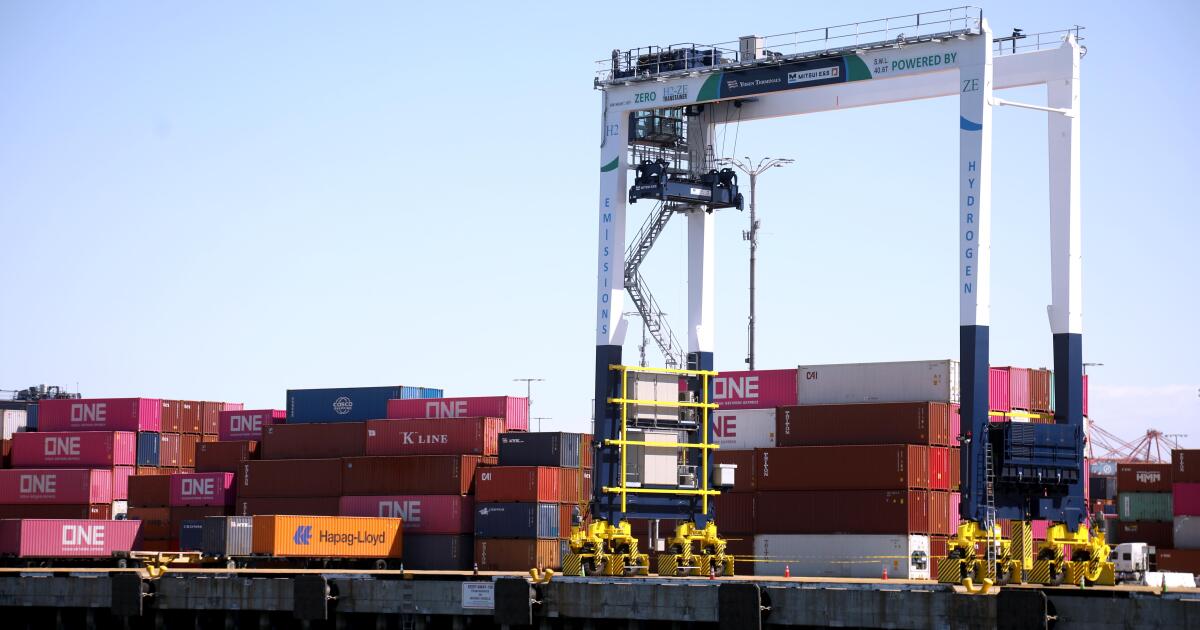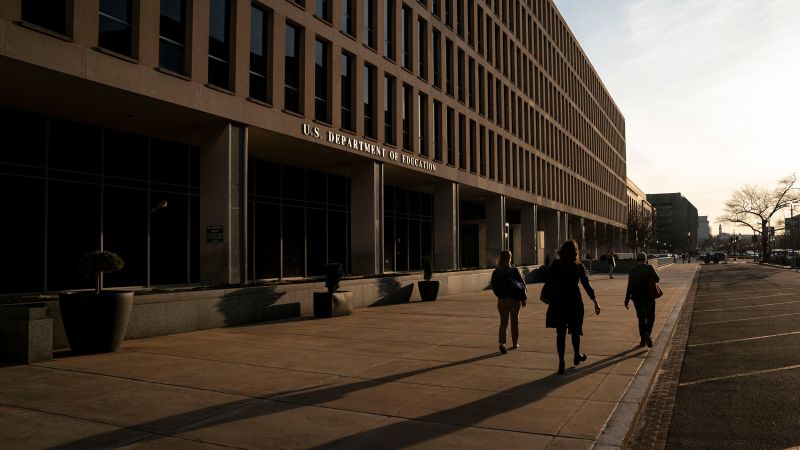California
California storm dumps record-breaking rain, nearly a foot of snow

A pedestrian uses an umbrella to shield themself during a rainstorm in San Francisco on March 28, 2023. More widespread rainfall was recorded last week due to an unpredictable storm system.
Douglas Zimmerman/SFGATE
The San Francisco Bay Area received “a pretty good soaking” of widespread rain on Saturday after offshore winds finally moved an unusually unpredictable storm system eastward through the region, causing temporary flooding, ponding in the roadways and some scattered lightning.
“It was the wettest day of the week by far,” Rick Canepa, a meteorologist for the National Weather Service’s Bay Area office, said Sunday. “It was a long wait for that [storm] to get here, and it was a pretty complex system, that’s for sure.”
Last week, forecasters were scratching their heads as they tried to determine how the looming storm would play out, noting at the time that the models were trending in “completely different directions” in terms of rainfall intensity. At first, forecasts indicated the possibility of an atmospheric river.
“But it’s been some years since we’ve had this much struggle with a single weather system,” Canepa said. “It wasn’t just one low [or storm] at times. There were two to three lows within the low that were trying to develop at the same time, causing it to wobble in direction a bit. It’s been a humbling experience, knowing how some of the best computer models in the world were struggling with the structure and complexity of that low-pressure system alone.”
Advertisement
Article continues below this ad
A few hundredths of an inch of rain started to trickle down on Tuesday, and trace amounts continued to fall throughout the week before the washout on Saturday. Canepa said the North Bay got the most rainfall last week – about one to three inches of rain on average with a whopping total of 4.82 inches measured at Venado’s rain gauge in Sonoma County, one of the wettest spots in the region. Meanwhile, Oak Ridge experienced 3.16 inches of rain, while Bodega Bay and Maribel Park saw 2.48 inches and 2.75 inches of rain, respectively.
The Santa Cruz Mountains all the way up to Daly City and San Bruno were next in line, with 2.29 inches of rain soaking Las Cumbres, 2.25 inches in Loma Prieta, 2.24 inches on Ormsby Road, 1.85 inches in Boulder Creek and 1.76 inches in San Lorenzo Valley.
Just about fourth tenths of an inch to an inch of rain was recorded along the San Francisco Bay shoreline, with 1.27 inches of rain drizzling over downtown San Francisco, 1.08 inches of rain at Mount Diablo and two tenths to nearly an inch of rain across the East Bay.
Advertisement
Article continues below this ad
“These are healthy rain totals that help greatly reduce the nearer term deficits that we’re just beginning to get,” Canepa said. “We’ve gotten rain before this, but this helps catch us up for the season to date.”
Outside of the region, the Paso Robles airport reported a record-breaking total of 1.74 inches of rain, far surpassing the previous record of 0.51 inches in 1982. Canepa highlighted just how staggering that was, noting the precipitation average for that site is typically 0.87 inches during the entire month of November, and 1.98 inches in December. “This is comparable to a month’s worth of December rainfall, and they recorded that in a single day,” he said.
The storm is currently moving across the Rockies and is expected to impact the East Coast by Tuesday night, Canepa said. Meanwhile, the Bay Area will be left with dry weather and mild daytime temperatures in the mid-to-high 60s and low 70s on Monday and Tuesday. Breezy to gusty winds are expected to develop late Sunday evening in higher elevations at speeds of 20 to 30 mph, which may blow around some debris and cause small branches to break off tree limbs. People are advised to secure any lightweight loose objects outdoors, use caution when operating high-profile vehicles and avoid burning anything outdoors.
Advertisement
Article continues below this ad
“Power outages are possible, but for the time being we’re not anticipating the need for a wind advisory,” Canepa said. “We’ll continue to closely monitor things and see how they develop.”
Along the California-Nevada border, an early winter storm brought as much as 10 inches of snow to Mt. Rose Ski Tahoe, seven inches to Mammoth Mountain ski base, four inches to Palisades and 0.8 inches to the Central Sierra Snow Lab. Peak wind gusts were as high as 154 miles per hour over the ridgetops of Ward Mountain, 84 mph at Heavenly and 52 mph at Lake Tahoe.
A winter weather advisory remains in effect until 10 p.m. Sunday for the Ruby Mountains and East Humboldt Range as total snow accumulations of three to 10 inches are expected at elevations up to 8,000 feet, and 12 to 18 inches above 8,000 feet, with wind gusts of up to 55 mph.
Advertisement
Article continues below this ad
“It’s a pretty typical late fall, early winter storm,” said Edan Lindaman, a meteorologist with the weather service’s Reno office. She noted conditions for travel appeared to be promising because the region is expected to trend toward warmer, drier conditions through at least Wednesday.
“But it is a reminder that we are heading into the winter season,” Lindaman continued. “If you’re planning to travel into the Sierra, Tahoe Basin or Mono Lake, carry your winter travel kit and check the roads before you go.”

California
Trump’s Department of Energy targets California and other blue states for budget cuts, according to internal documents

The Trump administration’s efforts to dismantle environmental protections and roll back nationwide progress toward clean energy disproportionately target California and other blue states, internal documents show.
As early as this week, the Department of Energy may pull funding from hundreds of projects — many of which were bolstered by President Biden’s bipartisan infrastructure law and are geared toward climate-friendly initiatives such as solar power, heat pumps, battery storage and renewable fuels, according to a leaked list reviewed by The Times.
The cuts could include as many as 262 projects in the DOE’s Office of Energy Efficiency and Renewable Energy, of which roughly 80% are based in states that did not go for Trump in the 2024 presidential election.
Also on the chopping block are nearly two dozen projects in the Office of Clean Energy Demonstrations, including a major national effort known as the Regional Clean Hydrogen Hubs (H2Hubs) Program, which aims to accelerate the development of hydrogen projects that can replace planet-warming fossil fuels.
Those cuts, too, are not applied equally: Of the seven states and regions selected to participate in the $7-billion federal hydrogen project, the four set to be gutted are in primarily Democratic areas.
The hydrogen incubators on the cut list include a hub in California; a Mid-Atlantic hub in Pennsylvania, Delaware and New Jersey; a Pacific Northwest hub in Oregon, Washington and Montana; and a Midwest hub in Illinois, Indiana and Michigan.
Meanwhile, the hydrogen hubs in red states and regions are safe, the list shows, including a large hub in Texas; a “heartland” hub in Minnesota, North Dakota and South Dakota; and an Appalachia hub in Ohio, West Virginia and Pennsylvania.
Officials with the Department of Energy did not immediately respond to a request for comment.
California was among 33 applicants for the competitive initiative, which launched in 2021 and ultimately selected seven “hubs” to develop and test various sources of hydrogen.
The California hub — known as ARCHES, or the Alliance for Renewable Clean Hydrogen Energy Systems — was awarded $1.2 billion in federal funds, with plans to bring in an additional $11.2 billion from private investors.
But it now faces cuts from Trump’s DOE despite the fact that the hub was the highest-scoring applicant among those considered for the federal award, according to sources familiar with the matter.
Democratic staff members with the House Science Committee who agreed to speak on background said the findings indicate that the cuts are partisan and ideological in nature — a trend in keeping with other actions from the Trump administration, which has repeatedly targeted environmental programs in California and other Democratic areas in recent weeks.
Indeed, cost alone does not appear to be a factor, given that Texas’s hydrogen hub received the same amount of federal funding — $1.2 billion — as California’s, yet the former was not on the cut list. The two states’ projects were the costliest of the hubs, which range from roughly $750 million to $1.2 billion.
The total cuts from the DOE’s Office of Energy Efficiency and Renewable Energy amount to more than $905 million, with about $735 million coming from blue states and $169 million from red states, according to a Times analysis.
Insiders said the proportions do not reflect overall clean energy investments by red and blue states, with Republican states such as Texas — a clean energy juggernaut — facing far fewer cuts from that office. According to documents reviewed by The Times, only eight Texas projects are on the chopping block compared with 53 in California.
House Science Committee staffers cautioned that the leaked lists represent a snapshot in time and that the administration could change its plans before making any official announcements.
Already, they said, some Republican representatives and private industry leaders have been successful in stopping certain projects from being canceled. So far, none of their Democratic counterparts have been able to do the same, they said.
The cuts could have considerable implications for the nation’s energy future.
The seven hydrogen hubs were collectively expected to produce 3 million metric tons of hydrogen each year — reducing 25 million metric tons of carbon dioxide emissions, or roughly the amount of 5.5 million gas-powered cars.
Each of the seven hubs was experimenting with different sources of hydrogen, with California focused on producing hydrogen exclusively from renewable energy and biomass while other hubs worked with natural gas, nuclear power and renewable sources such as wind and solar.
Officials with ARCHES said it could be weeks before they have more clarity on the situation.
“ARCHES remains committed to working with our partners to establish a secure, reliable and competitive hydrogen ecosystem, creating hundreds of thousands of good-paying jobs and delivering substantial health and economic benefits for Californians,” Chief Executive Angelina Galiteva said in a statement. “We have nothing more to share at this time.”
Hydrogen is also not without controversy. Critics have expressed concern that producing hydrogen is water- and energy-intensive, potentially dangerous to transport and expensive.
Supporters say it fills in a key gap that electrification alone cannot cover, particularly for heavy industries such as manufacturing and transportation.
ARCHES planned to fund at least 37 smaller projects in and around California, including efforts to decarbonize the Port of Los Angeles, as well as plans to install more than 60 hydrogen fueling stations around the state.
The status of those projects remains unclear.
The president — who received record donations from fossil fuel companies during his campaign — has taken aim at what he describes as “environmental extremists, lunatics, radicals and thugs” in recent weeks, vowing instead to ramp up the production of coal, increase oil drilling and block California’s efforts to transition to electric vehicles, among other actions.
California
9-year-old girl in California dies after dental surgery under anesthesia

A 9-year-old girl in California died after a dental surgery during which she was under anesthesia, according to the County of San Diego Medical Examiner’s Office.
Silvanna Moreno’s procedure took place at a dentist office in Vista on March 18, the medical examiner’s office said in a press release, providing an address for Dreamtime Dentistry. Following the surgery, she was moved to a recovery room and later discharged.
Dr. Ryan Watkins, a dentist anesthesiologist with Dreamtime Dentistry, said in a statement given to CBS 8 San Diego that standard post-anesthesia protocols were followed and Moreno “was discharged in stable condition — awake, with stable vital signs and protective reflexes intact — into her mother’s care.”
The medical examiner’s office, however, said she “remained asleep during her transport home” and “stayed sleeping” when she was put into her bed at home. The 9-year-old’s family checked on her throughout the day “to later find her unresponsive in bed,” according to the release.
Moreno’s family called 911 for help and first responders transported her to the Rady Children’s Hospital emergency department where she was later pronounced dead.
The medical examiner’s office did not immediately respond when asked to clarify Moreno’s condition when she was discharged.
The young girl’s cause of death is still under investigation. Watkins said the dentist office was fully cooperating with the investigation.
“The safety and well-being of our patients have always been and remain our highest priority. While we understand the concerns and questions surrounding this tragic event, we respectfully ask for patience as the investigation proceeds,” Watkins said. “For the sake of the family and the integrity of the process, we encourage restraint regarding speculation.”
A funeral for Moreno was held on Wednesday, March 26, CBS 8 reported.
California
California vs. Trump: What it’s like to be the attorneys on the front lines

Michael Newman, head of the civil rights enforcement section in California Atty. Gen. Rob Bonta’s office, was exhausted.
Newman and his legal team had just worked all weekend, straight through that Monday and overnight into Tuesday on a growing pile of legal challenges to the Trump administration, and were overdue for some sleep.
But on his drive home, he was alerted that the administration “cut half the Department of Education’s workforce,” Newman said. “And it’s like, ‘OK, well … That’s not happening.’”
Senior Assistant Atty. Gen. Michael Newman, center, along with members of his Civil Rights Enforcement Section on litigation challenging the Trump administration.
(Allen J. Schaben / Los Angeles Times)
The team went back to work, along with others in Bonta’s office, and by Thursday joined with other Democrat-led states to file a new lawsuit to block the firings.
“That’s kind of an idea of what life is like for the litigators,” Newman said. “Just when you think it’s safe to log off from your laptop, you get the text that [says], ‘Did you see this newest order that just came out?’”
For months now, President Trump’s pace of pronouncements, executive orders and dramatic policy shifts has been so swift, their reach so sweeping, that many Trump critics have felt overwhelmed and alarmed. They have also bemoaned the Democratic response as inept, haphazard and ineffective, particularly in Congress.
But since Trump’s January inauguration, attorneys in Bonta’s office — and in the offices of Democratic attorneys general nationwide — have been in an all-out sprint to keep up and push back. They’ve been carefully planning for even longer, including by reviewing litigation from Trump’s first term; listening to Trump’s promises on the campaign trail; assessing lawsuits against the Biden administration by conservative states; and culling through Project 2025, the controversial game plan for the president’s second term.
The result has been a rapid-fire slate of lawsuits challenging Trump’s policies, including his order purporting to end birthright citizenship for the American-born children of immigrants, his attempt to cut off trillions of dollars in federal funding already appropriated by Congress for programs in California and across the country, and his firing of federal probationary employees in veterans programs, national parks and other agencies.
They also have sued to block cuts to National Institutes of Health funding for universities and other research institutions, the termination of K-12 teacher training and preparation grants, billionaire Elon Musk’s informal but prominent role in federal government and access to sensitive data by his Department of Government Efficiency, which is not a real government agency.
In addition to their own lawsuits, Bonta and other Democratic attorneys general have supported challenges to Trump administration attacks on transgender service members, refugees, immigrants, a National Labor Relations Board official, the Consumer Financial Protection Bureau and law firms that have angered Trump with their legal work.
Trump administration officials have defended all of the policies as fulfilling the president’s promises to voters. They have dismissed California’s legal objections as misguided attempts to interfere with Trump’s presidential authority, and denounced court rulings halting or limiting their policies as the work of liberal “activist” judges.
California sued the first Trump administration about 120 times over four years, often with success. In the first eight weeks of the current administration, Bonta’s office joined other states in filing eight legal actions, a pace that if maintained would lead to more than 100 lawsuits against the new administration in its first two years. And that’s not counting filings in support of other lawsuits, of which there have been at least a half-dozen.
In February, Gov. Gavin Newsom signed legislation authorizing an additional $25 million to finance the state’s court battles with the Trump administration, plus another $25 million to support legal services for immigrants.
Bonta said his office is not working to assert a liberal agenda, but to uphold the Constitution and other federal law — and that it is the Trump administration setting the pace for lawsuits.
“If they decide they’re going to stop breaking the law, then we’ll stop filing lawsuits,” he said. “It’s that simple.”
‘We’re ready, we’re doing this’
After Trump won the election, Newman — a 46-year-old Los Angeles native and Pepperdine Law grad — gathered his team of civil rights attorneys, paralegals and others for a pep talk. There was sadness and some fear in the room, but also confidence, “like, we’re ready, we’re doing this, we’re getting on it,” he said.
“If we’re going to be in this world, in this country, at this time,” he told them, “I think it’s actually very empowering for us to be able to be the tip of the spear in the fight to prevent the worst-case scenarios.”
The team got to work refreshing its arguments from the last Trump administration and zeroing in on new policies it expected Trump to roll out, Newman said.
Still, there was a lot it didn’t know.
Every new policy requires a different legal analysis, not just of its substance and detail but of the administration’s legal justification for it, Newman said. “It’s not just what they do, it’s how they do it,” he said. “And so a lot of that stuff does require fine-tuning at the end.”
The state also needs to be able to clearly articulate how a federal policy it intends to challenge would harm California, a process Newman said Bonta has been particularly and personally engaged in — “making those decisions and determinations himself.”
By Inauguration Day — which fell on the Martin Luther King Jr. holiday — attorneys throughout Bonta’s office stood ready to launch. They were all watching Trump’s speeches that day and “in real time sorting out what the priorities were,” Newman said.

Bonta, left, is briefed by Newman.
(Allen J. Schaben / Los Angeles Times)
Bonta said Trump’s “blitz of executive orders” was clearly intended to create “shock and awe,” to “flood the zone” and create “confusion and chaos” — enough to overwhelm the administration’s opponents.
But his team was ready, he said.
Their first target was Trump’s order purporting to end birthright citizenship. It was something Trump had telegraphed he would do, and something they — and other blue states — were confident was illegal and could be overturned in court. They sued the very next day, calling the order unconstitutional. Judges quickly agreed, blocking the order from taking effect.
Another early target — the Office of Management and Budget memo purporting to halt trillions of dollars in federal funding — was not something they anticipated, Bonta said, and so they tackled it on the fly.
Bonta learned of the memo, issued a week after Trump’s inauguration, on his way home from an event with law students in San Francisco, and was caught off guard, he said. “That wasn’t necessarily on our bingo card that you might want to, overnight, try to pause $3 trillion in critical essential federal funding,” he said.
Texts and emails began flying between his leadership team and those of other Democratic attorneys general, he said, and they quickly agreed that “we had to file something immediately, the next day,” Bonta said — and “that meant some folks are not getting any sleep.”
That night stands out vividly for Christina Bull Arndt, who as chief counsel for special litigation in Bonta’s office helped coordinate the response among the states.
The night began with emails asking attorneys across the country if they were up for an all-nighter.
Attorneys on the East Coast worked feverishly until about 2 a.m. — 11 p.m. in California — and then handed their work off to their West Coast counterparts, who continued working deep into the morning until the East Coast attorneys woke up, took back over and filed the case that day in federal court in Rhode Island, Arndt said.
Arndt — a 57-year-old UCLA Law grad who grew up in San Diego — said she will never forget sitting in her home office that night “looking at that screen with all these people from across the country saying, ‘OK, who’s doing what? We gotta get this done.’”
It was inspiring, she said.
“This is gonna sound sappy, and I don’t care: I work with a bunch of people who care tremendously about what they’re doing, who really want the best for Californians, who want to do the right thing by the people of this country,” she said. “I am grateful all the time that I get to work with these people — who just want to get after it.”
A federal judge has since blocked the funding freeze, though Bonta’s office is still asking the court to better enforce its order, citing failures by the administration to release Federal Emergency Management Agency funding for wildfire recovery.
A legal war
With Congress firmly in Republican control, resistance to Trump’s many novel and legally dubious actions has fallen almost entirely to those willing to challenge the administration in court — an endeavor more perilous than expected.
Trump and his allies have not only criticized legal rulings against their policies, but called for individual judges to be impeached for issuing such decisions. Those calls, an astonishing affront to the rule of law from a presidential administration, drew a rare rebuke from Chief Justice John G. Roberts Jr., but that hasn’t stopped them.
Trump also has gone after law firms that have helped clients challenge him or his agenda in the past, targeting them for punishment unless they fall in line with his demands. And he recently stunned the legal world by issuing a presidential memorandum threatening all law firms with sanctions, revoked security clearances and other punishments if his administration determines that they have improperly sued the federal government.
The administration also has sought to rein in the power of states to sue the federal government, including in arguments to the Supreme Court in the birthright citizenship litigation. Legal experts say such state lawsuits have expanded exponentially under recent administrations of both parties, and that there is legitimate legal disagreement over their validity, particularly in cases where state powers are not at stake.
California’s attorney general is the state’s top law enforcement official, and is charged with defending the civil rights and legal and consumer interests of California residents and serving as legal counsel to state officials and agencies, among other things.
According to legal experts, state attorneys general have always been empowered to sue the federal government, particularly in order to challenge federal statutes or regulations that they believe overreach or undermine state law. Their legal authority to challenge federal policies for other reasons, such as when they harm or infringe on the rights of state residents, is more muddled, the experts said.

Bonta, center, as well as Arndt, left of Bonta, and Newman, right of Bonta, is briefed by members of his Civil Rights Enforcement Section.
(Allen J. Schaben / Los Angeles Times)
Tara Leigh Grove, a University of Texas School of Law professor who has written about state standing in such cases, said state attorneys general have been building out their litigation capabilities for the last 40 years, but have increasingly sued the federal government since a 2007 Supreme Court decision was interpreted within the legal community as bolstering their standing to do so.
Bonta said he is not surprised the Trump administration is challenging the power of states to sue now, given their stack of wins against the administration.
“We’re active, we’re organized, we’re making a difference. We’re stopping their unlawfulness. We’re standing up for the rule of law and the Constitution, and they don’t like it, so they want to reduce our power and influence,” he said.
Newman said the attorneys on his civil rights team are certainly up for the fight. They are “clear-eyed” about the Trump administration’s retaliation efforts — “We know that they’re obsessed with enemies and people who stand in their way,” he said — but undaunted.
That work is “exhausting and frustrating,” he said, but also incredibly rewarding.
“There’s no better feeling in the world,” he said, “than stopping an abuse of power based on the legal principles and strategy that you have developed.”
-

 Movie Reviews1 week ago
Movie Reviews1 week agoFilm Review: Rachel Zegler is the Best Part of an Otherwise Dull Remake of ‘Snow White’ – Awards Radar
-

 News1 week ago
News1 week agoShooting at Park in New Mexico Leaves at At Least 3 Dead and 16 Injured
-

 Education1 week ago
Education1 week agoICE Tells a Cornell Student Activist to Turn Himself In
-

 Politics1 week ago
Politics1 week agoEXCLUSIVE: Groundbreaking new prayer book designed for demographic most targeted for abortion
-

 News6 days ago
News6 days agoTrump Is Trying to Gain More Power Over Elections. Is His Effort Legal?
-

 News1 week ago
News1 week agoWashington Bends to RFK Jr.’s ‘MAHA’ Agenda on Measles, Baby Formula and French Fries
-

 News1 week ago
News1 week agoDismantling the Department of Education will strip resources from disabled children, parents and advocates say | CNN
-

 News1 week ago
News1 week agoLeft-Wing Democrats Wait on AOC’s Decision as They Look to 2028 Election

















